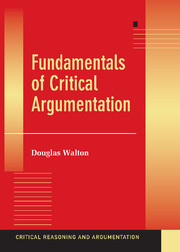TWO - CONCEPTS USEFUL FOR UNDERSTANDING ARGUMENTS
Published online by Cambridge University Press: 05 June 2012
Summary
This chapter introduces fundamental concepts needed to identify, analyze, and evaluate arguments. It is most vital to be able to recognize deductive arguments and to be able to contrast them with two other types of arguments. One is the inductive type of argument based on probability. The other is the presumptive type of argument based on plausibility. It is necessary to begin with deductive arguments, as these are the kind that have been most intensively studied in logic and about which most is known. From there, the chapter goes on to examine the distinction between an explanation and an argument. Mainly in this book we are concerned with arguments. But there is a common tendency to confuse arguments and explanations, and the problem of distinguishing between the two has to be dealt with if we are to avoid the error of treating something as an argument when it is not. The chapter begins with the notion of inconsistency and its role in argumentation. This notion is fundamental to defining and recognizing deductive arguments as a distinctive type.
There can also be much confusion in mixing up the three kinds of arguments, and the clues in a dialogue on which type was meant to be put forward can be subtle. Even so, one can begin to get a good fundamental grasp of how to recognize each type of argument by learning about its success criteria. Each type of argument has a distinctive structure.
- Type
- Chapter
- Information
- Fundamentals of Critical Argumentation , pp. 43 - 83Publisher: Cambridge University PressPrint publication year: 2005



